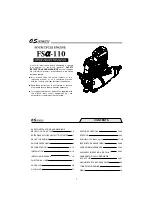
Clean water is the only cleaning agent that is
required when ELC is drained from the cooling
system.
Before the cooling system is filled, the heater control
(if equipped) must be set to the HOT position. Refer
to the OEM to set the heater control. After the cooling
system is drained and the cooling system is refilled,
operate the engine until the coolant level reaches the
normal operating temperature and until the coolant
level stabilizes. As needed, add the coolant mixture
to fill the system to the specified level.
Changing to Perkins ELC
To change from heavy-duty antifreeze to the Perkins
ELC, perform the following steps:
NOTICE
Care must be taken to ensure that all fluids are con-
tained during performance of inspection, mainte-
nance, testing, adjusting and the repair of the
product. Be prepared to collect the fluid with suitable
containers before opening any compartment or disas-
sembling any component containing fluids.
Dispose of all fluids according to local regulations
and mandates.
1.
Drain the coolant into a suitable container.
2.
Dispose of the coolant according to local
regulations.
3.
Fill the cooling system with a 33 percent solution of
Perkins ELC and operate the engine, ensure that
the thermostat opens. Stop the engine and allow
the engine to cool. Drain the coolant.
Note:
Use distilled or deionized water in the solution.
4.
Again, fill the cooling system with a 33 percent
solution of Perkins ELC and operate the engine
ensure that the thermostat opens. Stop the engine
and allow to cool.
5.
Drain the cooling system.
NOTICE
Incorrect or incomplete flushing of the cooling system
can result in damage to copper and other metal
components.
6.
Fill the cooling system with the Perkins Premixed
ELC. Operate the engine. Ensure that all coolant
valves open then stop the engine. When cool
check the coolant level.
ELC Cooling System Contamination
NOTICE
Mixing ELC with other products reduces the effective-
ness of the ELC and shortens the ELC service life.
Use only Perkins Products for premixed or concen-
trate coolants. Failure to follow these recommenda-
tions
can
result
in
shortened
cooling
system
component life.
ELC cooling systems can withstand contamination to
a maximum of 10 percent of conventional heavy-duty
antifreeze or SCA. If the contamination exceeds 10
percent of the total system capacity, perform ONE of
the following procedures:
• Drain the cooling system into a suitable container.
Dispose of the coolant according to local
regulations. Flush the system with a 5 to 10
percent solution of Perkins ELC. Fill the system
with the Perkins ELC.
• Drain a portion of the cooling system into a
suitable container according to local regulations.
Then, fill the cooling system with premixed ELC.
This procedure should lower the contamination to
less than 10 percent.
• Maintain the system as a conventional Heavy-
Duty Coolant. Treat the system with an SCA.
Change the coolant at the interval that is
recommended for the conventional Heavy-Duty
Coolant.
Commercial Heavy-Duty Antifreeze and
SCA
NOTICE
Commercial Heavy-Duty Coolant which contains
Amine as part of the corrosion protection system
must not be used.
NOTICE
Never operate an engine without water temperature
regulators in the cooling system. Water temperature
regulators help to maintain the engine coolant at the
correct operating temperature. Cooling system prob-
lems
can
develop
without
water
temperature
regulators.
Check the antifreeze (glycol concentration) to ensure
adequate protection against boiling or freezing.
Perkins recommends the use of a refractometer for
checking the glycol concentration. A hydrometer
should not be used.
Perkins engine cooling systems should be tested at
500-hour intervals for the concentration of SCA.
Additions of SCA are based on the results of the test.
An SCA that is liquid may be needed at 500-hour
intervals.
38
SEBU9077-01
















































